| |
Encounters: Facing “West”
|
The Japanese visualization of these first encounters presents a different
world. This is true not only of artwork churned out at the time, but
also of evocations of the Perry mission that artists produced in later
years. It mattered greatly, of course, that whereas the Americans
were observing the Japanese in their native milieu, the Japanese were
confronting intruders far from home.
For the Japanese, that is, the foreigners who suddenly materialized
in their waters and descended upon their soil had no context, no tactile
background. They existed detached from any broader physical and cultural
environment. Whereas Heine and his colleagues could attempt to present
“Japan” to their audience, the Japanese had only a small
number of “Americans” and their artifacts upon which to
focus.
There was, moreover, no counterpart on the Japanese side to the official
artists employed by Perry—and thus no Japanese attempt to create
a sustained visual (or written) narrative of these momentous interactions.
What we have instead are representations by a variety of artists,
most of whose names are unknown. Their artistic conventions differed
from those of the Westerners. Their works were reproduced and disseminated
not as lithographs and engravings or fine-line woodcuts, but largely
as brightly colored woodblock prints as well as black-and-white broadsheets
(kawaraban).
They also painted in formats such as unfolding “horizontal scrolls”
(emaki) that had no counterpart in the West. It was common
for such scrolls to be 20 or 30 feet long, and in some cases they
inspired variant copies. Many of these artists drew no boundary between
direct observation and flights of imagination. On occasion, tension
permeated their images—and no wonder. Their insular way of life,
after all, had been violated and would never be the same. Although
one might (and some did) pretend otherwise, it was obvious where the
preponderance of power lay.
|
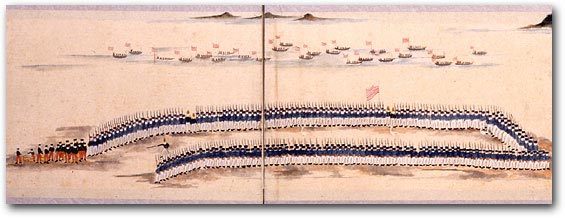 |
 Perry’s
troops landing in Yokohama, 1854 Perry’s
troops landing in Yokohama, 1854
Shiryo Hensanjo, University of Tokyo
|
Some
of these artistic responses reflected bravado and an attempt to rally
domestic support against the foreign threat. In anticipation of Perry’s
arrival, the Shogun’s government had mobilized its own samurai
forces and ordered daimyo (local lords) throughout the land to send
troops to defend the capital. Thousands of armed warriors manned the
shoreline when Perry landed on his two visits. In the renderings of
the Narrative, these soldiers and officials appear calm and unruffled,
even when mounted on horseback or challenging the American crew that
was surveying Edo Bay. And while tension inevitably accompanied these
encounters, discipline and order did prevail. No violent incidents
occurred, and Japanese renderings of the first meetings of the two
sides also convey a sense of formality.
There were even unanticipated occasions where each side had the opportunity
to observe and record a common solemn moment on the part of the other—a
funeral, in this instance—and did so with differing styles,
to be sure, but also with a shared respectfulness. Thus a lithograph
in the Narrative depicting a Buddhist funeral procession in Shimoda
has an interesting counterpart in a Japanese sketch of the American
funeral procession for marine private Robert Williams, who died of
illness during Perry’s second visit. After brief and courteous
negotiation, the Japanese not only agreed to allow the deceased to
be buried on Japanese soil, but also had Buddhist priests participate
in the funeral service. The respect the Americans showed to the dead
clearly helped weaken the familiar stereotypes of “southern
barbarians” and “foreign devils.” At the same time,
the American tolerance of Buddhist participation in the rites of interment
offers a striking contrast to more invidious popular evocations of
the Japanese as “heathen.”
|

Japanese funeral in Shimoda, from the official
Narrative
Funeral procession of Private Williams,
by Tohohata (Osuke) 1854
Shiryo Hensanjo,
University of Tokyo |
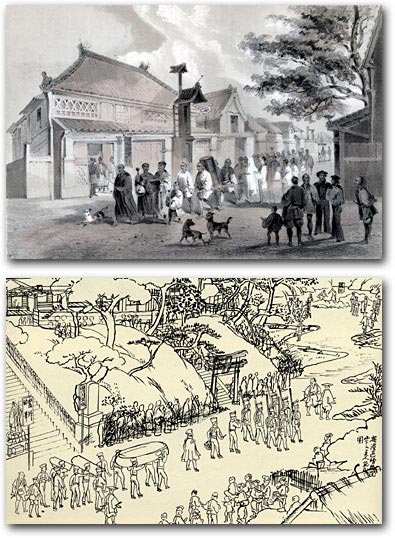
|
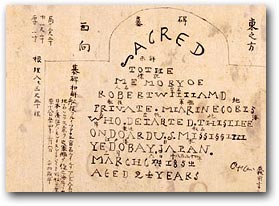
  Inscription
from Robert Williams’s gravestone in the 1854 “Black Ship Scroll” Inscription
from Robert Williams’s gravestone in the 1854 “Black Ship Scroll”
Honolulu Academy of Art |
So
great was the impression left by the death of Williams that the
long “Black Ship Scroll” painted in Shimoda in 1854
included a drawing of the inscription on his tombstone.
In all, four Americans with the Perry mission died and were buried
in Japan. Private Williams, originally buried in Yokohama, was reinterred
in Shimoda. One of Heine’s most evocative illustrations depicts
Americans and Japanese, including a Buddhist priest, in a hillside
cemetery in Shimoda, the American fleet visible at anchor in the
harbor.
 |
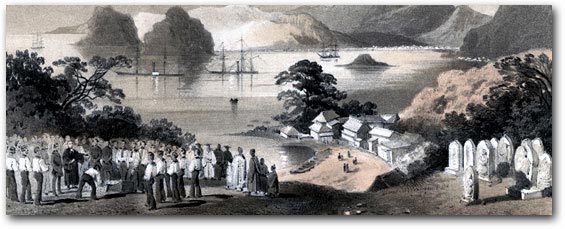 |
 Heine’s
1854 rendering of the harbor at Shimoda “from the Heine’s
1854 rendering of the harbor at Shimoda “from the
American Grave
Yard” (detail), from the official Narrative
|
 By
rare good fortune, we have a daguerreotype of the four American graves,
most likely taken the following year. Evocative in its own way, the
photograph also highlights the romanticism of Heine’s vision
of these historic encounters. By
rare good fortune, we have a daguerreotype of the four American graves,
most likely taken the following year. Evocative in its own way, the
photograph also highlights the romanticism of Heine’s vision
of these historic encounters.
 |
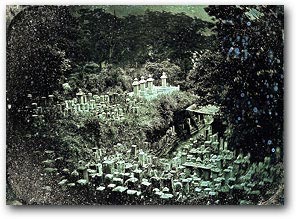 |
  Four
American gravestones in the cemetery of Gyokusenji
temple in Shimoda. Daguerreotype attributed to Edward Kern, ca. 1855 Four
American gravestones in the cemetery of Gyokusenji
temple in Shimoda. Daguerreotype attributed to Edward Kern, ca. 1855
George Eastman House
|
In
ways absent from the American graphics, however, Japanese artists
also succeeded in conveying a tense willingness to fight if need be
on the part of the Japanese defenders. Colored as well as black-and-white
prints depicted samurai crouched in readiness for imminent battle.
|
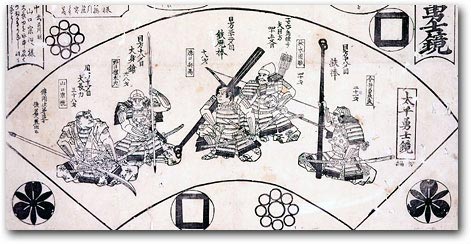 |
 Samurai
guards at Edo Bay, detail from a kawaraban broadsheet, 1854 Samurai
guards at Edo Bay, detail from a kawaraban broadsheet, 1854
Ryosenji Treasure Museum |

  Detail
from a montage titled “Pictorial Depiction of American People and Steamship” Detail
from a montage titled “Pictorial Depiction of American People and Steamship”
ca. 1854
Ryosenji Treasure Museum |
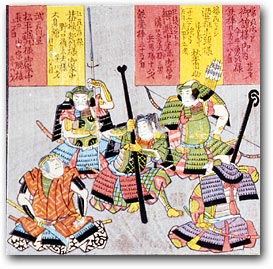 |
In some cases, the massive mobilization of samurai was conveyed in a
traditional “heraldic” manner. Here, depiction of the
foreign fleet sitting offshore was paired with a row of tiny drawings
of the distinctive crests, decorated staffs, and other insignia that
identified different daimyo and their retainers.
|
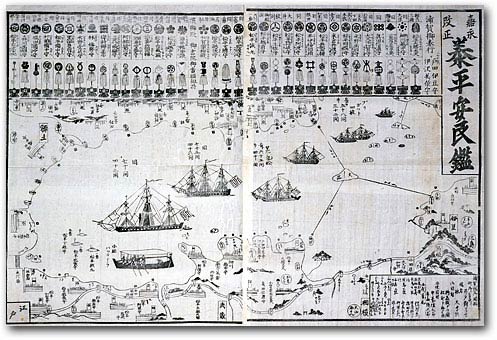 |
 Japanese
deployment against U.S. black ships at Edo Bay, 1854 kawaraban Japanese
deployment against U.S. black ships at Edo Bay, 1854 kawaraban
Ryosenji Treasure Museum
|
Even
decades later, after Japan’s new leaders had dismantled the
feudal system and embarked on a policy of ardent “Westernization,”
the image of heroic warriors bristling to take on Perry’s imperialist
intruders had an avid audience. The most flamboyant woodblock print
of the imagined samurai defenders in Edo Bay, for example, dates from
1889 and conveys a sense of both peril and gritty determination that
could still rouse the fervor of new nationalists in a new nation.
|
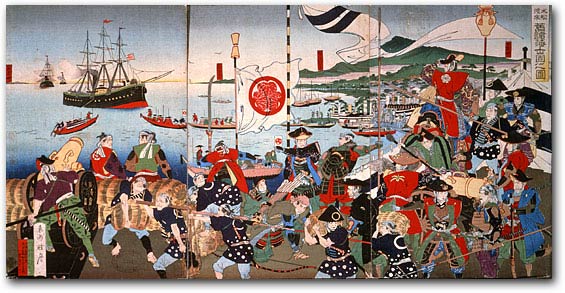 |
 Samurai
from various fiefs mobilize to defend the homeland against Perry’s
intrusion, Samurai
from various fiefs mobilize to defend the homeland against Perry’s
intrusion,
1889 woodblock print by Toshu Shogetsu
Shiryo Hensanjo, University of Tokyo
|
The
most audaciously fictional rendering of Perry and the Japanese was
circulated as a kawaraban broadsheet around 1854. This depicts
the commodore prostrating himself before an official in full samurai
armor seated on the traditional camp stool of a fighting general.
|

 
Perry
prostrating himself before a samurai official, kawaraban
(detail) ca. 1854
Ryosenji Treasure Museum
|
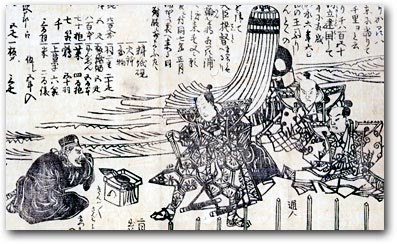 |

Widely
known for his haughty demeanor even before the Japan expedition, Perry
took extraordinary care never to display the slightest sign of subordination
or obsequiousness in his dealings with Japanese officials. Had he
seen this little pearl of propaganda, it surely would have made his
hair curl.
More than a few Japanese graphics had a cartoon quality, and some
were deliberately humorous—again, something never seen in the
sober American illustrations. One of the liveliest episodes that took
place during the second visit, for example, was a banquet on the Powhatan.
As it happens, we know from various sources that this evolved into
less than formal behavior. In an entertaining letter to his wife,
one of Perry’s officers (Lieutenant George Henry Preble) recounted
that, “in accordance with the old adage that if they eat hearty
they give us a good name,” he and his comrades took care to
keep the plates and glasses of their guests full. “Doing my
duty therefore, in obedience to orders,” he continued, “I
plied the Japanese in my neighborhood well, and when clean work had
been made of champagne, Madeira, cherry cordial, punch and whisky
I resorted to the castors and gave them a mixture of catsup and vinegar
which they seemed to relish with equal gusto.” Both sides interspersed
their libations with friendly toasts.
|
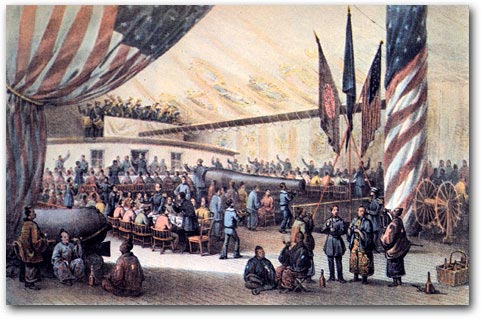 |
 Banquet
on board the Powhatan Banquet
on board the Powhatan
|
The
band played, and American officers danced with Japanese officials
in formal robes. One of the commissioners was so carried away by the
end of the evening that he threw his arms around Perry’s neck,
embraced him rather sloppily, crushed his epaulettes, and (in a subsequently
often-quoted phrase) burbled “Nippon and America, all the same
heart.” As Preble recounted the story, when asked how he could
tolerate such behavior, the commodore replied, “Oh, if he will
only sign the Treaty he may kiss me.” Gunboat diplomacy was
a demanding business.
One could never imagine any of this from Heine’s entirely decorous
rendering of the event in the official Narrative, and unfortunately no irreverent Japanese artists
were present to record the scene.
When the Japanese reciprocated with a banquet of their own, on the
other hand, we have not only a somber rendering of this (sketched
at the time but published as a woodblock print many years later),
but also an anonymous and quite disorderly print that suggests the
Westerners, although not required to sit Japanese style on the floor,
clearly had a difficult time swallowing the native cuisine.
|
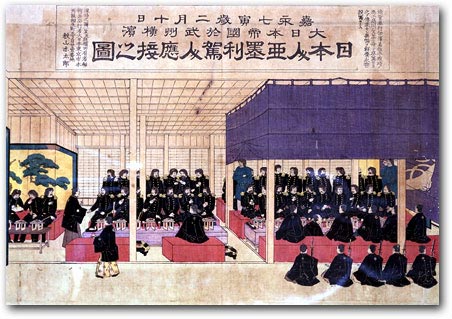 |

Japanese
reception for the Americans, late-19th-century woodblock print from
a sketch done at the time
Ryosenji Treasure Museum |


“Entertainment Held in the Reception Hall at Yokohama”
(detail), ca. 1854
Peabody Essex Museum |
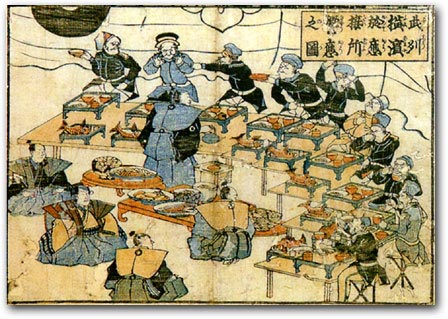 |
Frequently,
Japanese artists resorted to montage to convey a sense of the multifaceted
nature of the Perry encounter. The landing at Yokohama in March 1854,
for example, inspired a number of prints combining views of the black
ships at anchor with drawings of the commodore and his crew marching
in parade.
One elaborate montage, titled “Pictorial Depiction of American
People and Steamship,” featured a map of the world in the center
(with Japan in the center of the map), surrounded by depictions of
the curtained-off Japanese shore defenses, a gunboat belching smoke,
Perry and his attendants in rather untidy parade (the Americans had
better posture when their own artists drew them), the samurai in full
armor we already have seen, and crewmen from the black ships gaping
at the sight of two giant sumo wrestlers.
|


“Pictorial
Depiction of American People and Steamship”
ca. 1854
Ryosenji Treasure Museum |
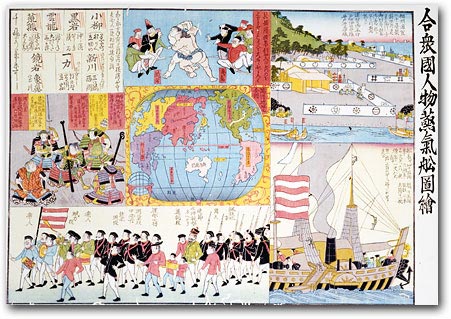 |
The
most spectacular assemblage of graphics, completed at a later date,
took the form of a dramatic eight-panel standing screen, now known as the “Assembled
Pictures of Commodore Perry’s Visit.” On this were affixed
depictions of the black ships, Perry and other members of his mission
(including ordinary crew), troops in formation, entertainments, artifacts
the Americans brought with them, and the official gifts they proffered
(including a telegraph apparatus and a small model train).
|
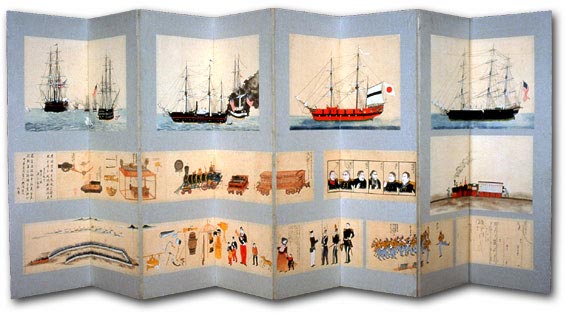 |
 “Assembled
Pictures of Commodore Perry’s Visit” “Assembled
Pictures of Commodore Perry’s Visit”
eight-panel folding screen
Shiryo Hensanjo, University of Tokyo
|
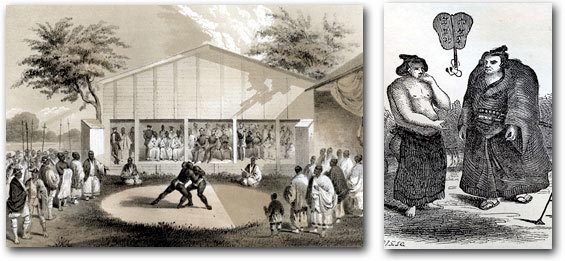 |
Sumo,
as it turned out, attracted artists on both sides. The Narrative featured
a lithograph (by W. T. Peters) of an outdoor sumo match observed by
a crowd of Japanese and Americans including Perry himself, as well
as a pencil drawing of two sumo champions by the always respectful
Heine.
The sumo wrestlers did not impress everyone favorably, however. The
Narrative described them as “over-fed monsters” and found
the wrestling matches themselves “disgusting”—a
mere “show of brute animal force.” In his personal journal,
Perry dismissed the bouts as a “farce” and referred to
the eventual winner as “the reputed bully of the capital, who
seemed to labor like a Chinese junk in chow-chow water.” The
sight of some twenty-five or thirty of these brawny men grouped together
struck him as “giving a better idea of an equal number of stall-fed
bulls than human beings.”
|
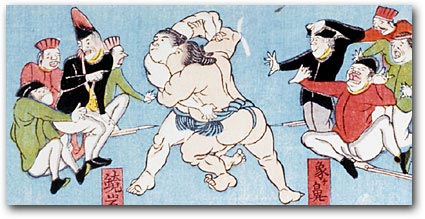 |

Sumo detail from
1854 montage
Ryosenji Treasure
Museum |
By
contrast, in Japanese eyes these same figures became an almost irresistible
vehicle through which to intimate Japan’s formidable strength,
against which the foreigners were puny and powerless. In the “Pictorial
Depiction of American People and Steamship” montage, the American
spectators appear small, ludicrous, and astonished at the sight of
two of these giants grappling with each other.
In the same spirit, the spectacle of these strongmen hefting huge
bales of rice the Americans were unable to budge (they weighed over
125 pounds) became another witty way of suggesting that the intruders
were no match for Japanese. A scroll of first-hand sketches of the
foreigners prepared by a retainer of the daimyo of Ogasawara included
skillful line drawings of awed marines examining the bulk of a sumo
champion.
Even Perry was given the opportunity to feel the muscles of one of
these giants. The artists naturally portrayed him as duly impressed,
although the official report tells us he was merely expressing surprise
“at this wondrous exhibition of animal development.”
|
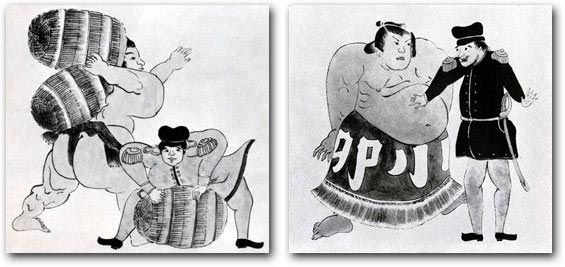 |
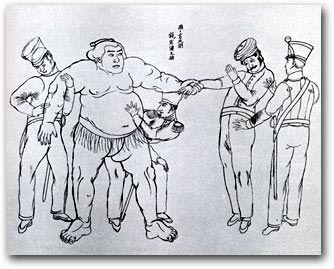 |

Sumo
wrestlers carry rice bales, 1854 (above, left)
Collection of DeWolf Perry
Perry and a Japanese wrestler, 1854 (above, right)
Collection of DeWolf Perry
Marines examining a sumo
wrestler, 1854 (left)
Smithsonian Institution |
In
the decade following the Perry expedition, the larger-than-life sumo
wrestler continued to provide a small vehicle for iconographic bravado.
After a new commercial treaty was signed in 1858 and foreigners began
to flood into the country, woodblock artists portrayed these native
heroes tossing around, not bales of rice, but the hairy barbarians
themselves.
|
 “The
Glory of Sumo Wrestlers at Yokohama,” “The
Glory of Sumo Wrestlers at Yokohama,”
1860 and 1861
Ryosenji Treasure Museum |
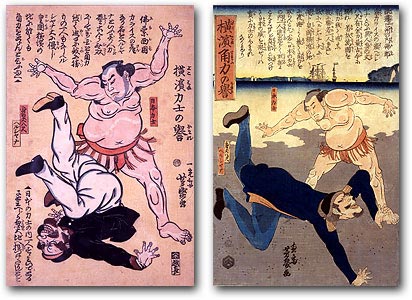 |
When
it came to promoting human curiosities, however, Perry was not to
be outdone. The American counterpart to the sumo wrestler was white
men in black-face, as well as flesh-and-blood Negroes.
|
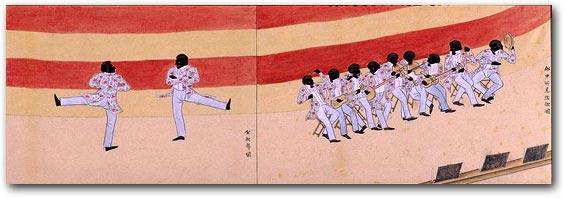 |
 Minstrel
show on Minstrel
show on
the Powhatan
Chrysler Museum of Art (above)
Shiryo Hensanjo,
University of Tokyo (right) |
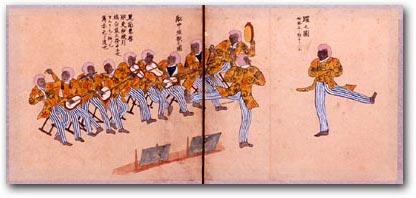
|
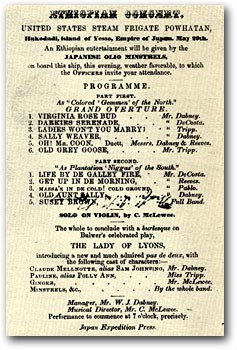 |

In
Japan (as well as elsewhere on the voyage to and from Japan), Perry’s
favorite entertainment was an “Ethiopian concert” featuring
white men playing the roles of “Colored ‘Gemmen’
of the North” and “Plantation ‘Niggas’ of
the South,” and singing such songs as “Darkies Serenade”
and “Oh! Mr. Coon.” Although the Narrative dwells on the
“delight to the natives” these performances gave, it remained
for Japanese artists to preserve them for posterity.
“Ethiopian Concert”
program from minstrel show
on the Powhatan |

From
the moment he first stepped on Japanese soil in 1853 to present the
letter from President Fillmore, Perry also sought to impress the Japanese
with authentic black men. “On either side of the Commodore,”
the Narrative tells us,
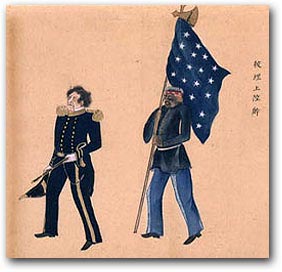
 Perry,
accompanied by a “tall,
well-formed negro,” delivering
President Fillmore’s letter,
1853 Perry,
accompanied by a “tall,
well-formed negro,” delivering
President Fillmore’s letter,
1853
Chrysler Museum of Art |
“marched a tall, well-formed negro,
who, armed to the teeth, acted as his personal guard. These blacks,
selected for the occasion, were two of the best-looking fellows of
their color that the squadron could furnish.” Here again, it
is the Japanese side that has left a graphic impression of these stalwart
aides.
In other Japanese renderings, however, blacks who accompanied the
mission were less than handsome and well-formed. When Perry and his
men visited the two treaty ports designated by the Treaty of Kanagawa,
artists in both Shimoda and Hakodate drew unflattering portraits of
black crewmen who came ashore. They would never be confused with the
stalwart standard bearers who flanked Perry when he presented the
president’s letter.
|
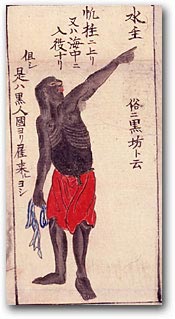 |
Crewman “hired from
a country of black people,”
from the watercolor
“Black Ship and Crew”
ca. 1854
Ryosenji Treasure Museum |
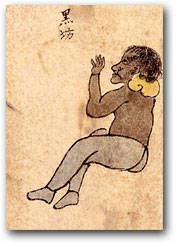 |

“Black man” from
the “Black Ship Scroll”
1854
Honolulu Academy of Art |
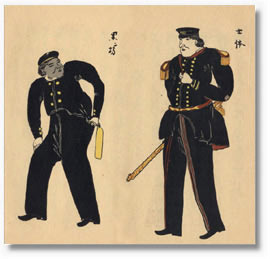 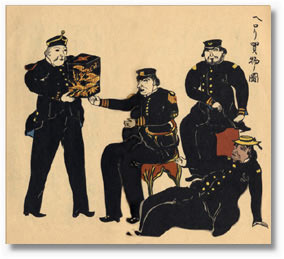
|
Two
images of Perry and black crew members in
Hakodate
Hakodate Kyodo Bunkakai
|
|
At
the time Perry was engaged in opening Japan to “civilization,”
slavery was still widespread in the United States and minstrel shows
were an enormously popular form of entertainment. (The Narrative dwells
at some length on their appealing combination of “grotesque
humor and comic yet sentimental melody.”) The Japanese, whose
prior contact with dark-skinned peoples was negligible, responded
to these encounters with undisguised curiosity. As filtered through
the eyes of popular artists, however, this interest emerges more as
bemusement about the human species in general than any clear-cut prejudice
toward foreigners, or toward blacks in particular.
This seems, at first glance, an unlikely response from a racially
homogeneous society that had lived in isolation for so long. It was,
however, a logical response when seen from the perspective of the
mass-oriented popular culture of late-feudal Japan. Whereas Heine
and his colleagues exemplified restrained “high art” traditions
of representation, Japanese artists catering to a popular audience
had long engaged in exaggeration and caricature. Their purpose was
to entertain, and in the tradition of woodblock prints in particular,
every conceivable type of subject, activity, and physical appearance
was deemed suitable for representation—whether it be scenery,
the “floating world” of actors and courtesans, mayhem
and grotesquerie, or outright pornography. This protean fascination
with the human comedy carried over to artistic renderings of the various
types of foreign individuals who came ashore with the commodore in
1853 and 1854.
It is in this spirit that the bare-chested black sailor in Shimoda
was introduced as but one of many characters in a popular scroll that
treated virtually all members of the expedition as rather odd but
essentially entertaining. The larger scene in which he appears includes
two “Chinese” who accompanied the expedition, as well
as a white man with a telescope.
|
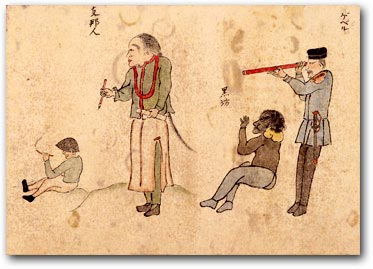 |
Chinese members of
the Perry expedition with
black crewman and white
man with a telescope
“Black Ship Scroll” (detail)
Honolulu Academy of Art
 |
 |
 |
 This
version of the “Black Ship Scroll” (beginning section
shown here) This
version of the “Black Ship Scroll” (beginning section
shown here)
is approximately 30-feet long and is read from right to left.
|
 |
|
This
“Black Ship Scroll” (which came to exist in several variant
copies) also featured witty renderings of crewmen engaged in activities that Perry’s artists
never dreamed of recording: inebriated sailors dancing, for example,
and a seaman surrounded by prostitutes. In a nice representation of
foreigners making their representations, the Shimoda scrolls also
included such scenes as Heine making sketches, Dr. Morrow collecting
and recording his specimens of plants, foreigners surveying the countryside,
and three aroused Americans (the tongue of one is protruding) making
a daguerreotype of a courtesan to present to the “American king.”
|
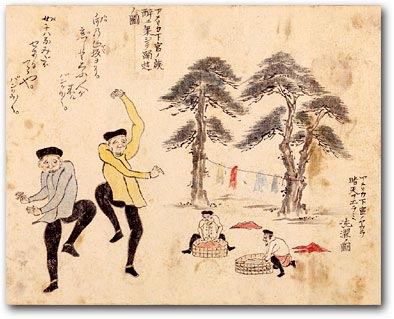 |

Inebriated American
crewmen dance,
while others
do their laundry |


An American sailor
ingratiating himself with prostitutes in Shimoda (together with a
long and amusing account of how he succeeded in doing so) |
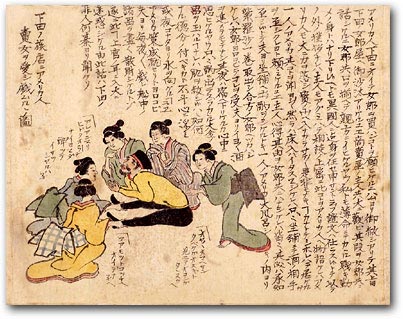 |
However
exaggerated such renderings may have been, they conveyed a playfulness
and vitality fully in keeping with the practices of Japanese popular
art—and conspicuously different from the high-minded “realism”
of Heine and company. From this perspective, the great cultural encounter
was genuinely amusing.
|
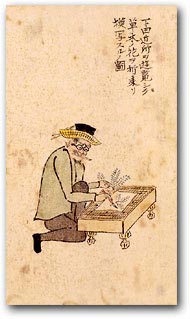 |
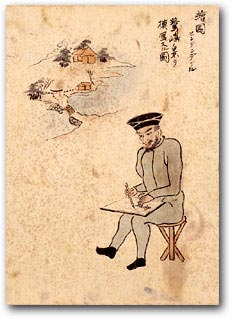 |

Botanist James Morrow and artist William Heine |


Surveying the
Shimoda countryside |
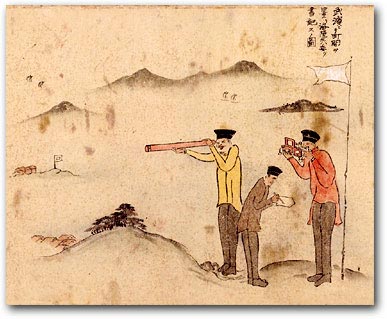 |
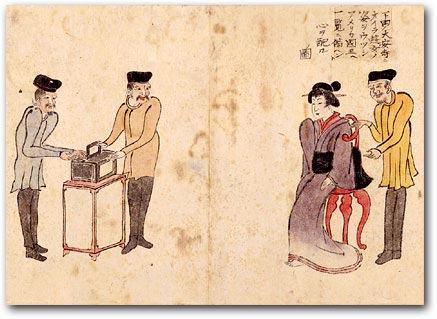 |
Eliphalet Brown, Jr.
and assistants
making a
daguerreotype of
a courtesan |

A bemused Japanese woman watches American sailors attempting to hull
rice |
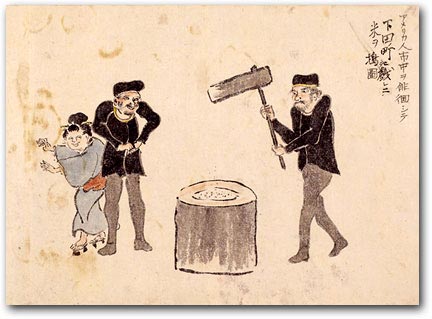 |
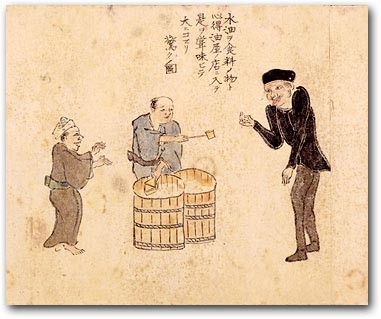 |
An American crewman
grimaces after tasting
hair oil he mistook for
an edible delicacy |
 |
 |
 A variant version
of the “Black Ship Scroll”
A variant version
of the “Black Ship Scroll”
|
|
|

